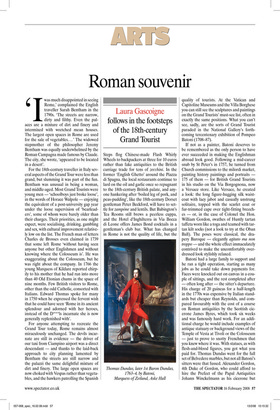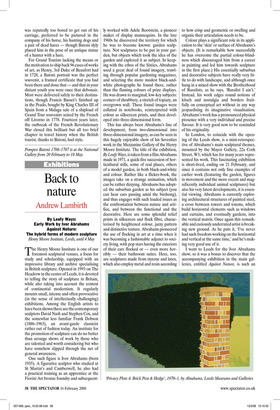Roman souvenir
Laura Gascoigne follows in the footsteps of the 18th-century Grand Tourist
‘I was much disappointed in seeing Rome,’ complained the English traveller Sarah Bentham in the 1790s. ‘The streets are narrow, dirty and filthy. Even the pal aces are a mixture of dirt and finery and intermixed with wretched mean houses. The largest open spaces in Rome are used for the sale of vegetables... ’ The widowed stepmother of the philosopher Jeremy Bentham was equally underwhelmed by the Roman Campagna made famous by Claude. The city, she wrote, ‘appeared to be located in a desert’.
For the 18th-century traveller in Italy several aspects of the Grand Tour were less than grand, but slumming it was part of the fun. Bentham was unusual in being a woman, and middle-aged. Most Grand Tourists were young men — ‘schoolboys just broke loose’, in the words of Horace Walpole — enjoying the equivalent of a post-university gap year under the loose supervision of ‘bearleaders’, some of whom were barely older than their charges. Their priorities, as one might expect, were socialising, drinking, gambling and sex, with cultural improvement relatively low on the list. The French man of letters Charles de Brosses even claimed in 1739 that some left Rome ‘without having seen anyone but other Englishmen and without knowing where the Colosseum is’. He was exaggerating about the Colosseum, but he was right about the company. In 1766 the young Marquess of Kildare reported chirpily to his mother that he had run into more than 40 Old Etonian chums in the space of nine months. Few British visitors to Rome, other than the odd Catholic, consorted with Italians. Edward Thomas spoke for many in 1750 when he expressed the fervent wish that he could have seen ‘Rome in its ancient splendour and adorned with her heroes, instead of the D***ls incarnate she is now generally replenished with’.
For anyone attempting to recreate the Grand Tour today, Rome remains almost miraculously unchanged. The devils incarnate are still in evidence — the driver of our taxi from Ciampino airport was a direct descendant — and thanks to the laid-back approach to city planning lamented by Bentham the streets are still narrow and the palazzi the same delightful mixture of dirt and finery. The large open spaces are now choked with Vespas rather than vegetables, and the hawkers patrolling the Spanish Steps flog Chinese-made Flash Whirly Wheels to backpackers at three for 10 euros rather than fake antiquities to the British carriage trade for tens of zecchini. In the former ‘English Ghetto’ around the Piazza di Spagna, the local restaurants continue to lard on the oil and garlic once so repugnant to the 18th-century British palate, and anyone hankering after ‘boiled leg of pork, and peas-pudding’, like the 18th-century Dorset gentleman Peter Beckford, will have to settle for zampóne and lentils. But Babington’s Tea Rooms still brews a peerless cuppa, and the Hotel d’Inghilterra in Via Bocca di Leone offers James Bond cocktails in a gentleman’s club bar. What has changed in Rome is not the quality of life, but the quality of tourists. At the Vatican and Capitoline Museums and the Villa Borghese you can still see the sculptures and paintings on the Grand Tourists’ must-see list, often in exactly the same positions. What you can’t see, sadly, are the sorts of Grand Tourist paraded in the National Gallery’s forthcoming tercentenary exhibition of Pompeo Batoni (1708–87).
If not as a painter, Batoni deserves to be remembered as the only person to have ever succeeded in making the Englishman abroad look good. Following a mid-career snub by St Peter’s in 1757, he turned from Church commissions to the milordi market, painting history paintings and portraits — 175 of them — for British Grand Tourists in his studio on the Via Borgognona, now a Versace store. Like Versace, he created a look: the long figure-hugging silk waistcoat with lacy jabot and casually unstrung solitaire, topped with the scarlet coat or fur-trimmed cape over tight-fitting breeches — or, in the case of Colonel the Hon. William Gordon, swathes of Huntly tartan taffeta worn like a toga and teamed with tartan kilt socks (not a look to try at the Oban Ball). The poses were classical, the drapery Baroque — elegantly agitato ma non troppo — and the whole effect immaculately contrived to make the uncomfortably overdressed look stylishly relaxed.
Batoni had a large family to support and he ran a tight operation, starting as many jobs as he could take down payments for. Faces were knocked out on canvas in a couple of sittings, and the rest completed after — often long after — the sitter’s departure. His charge of 20 guineas for a half-length in the 1770s was expensive by Italian standards but cheaper than Reynolds, and compared favourably with the cost of a course on Roman antiquities by the Scottish cicerone James Byres, which took six weeks and was famously hard work. For an additional charge he would include examples of antique statuary or background views of the Temple of Vesta at Tivoli or the Colosseum — just to prove to snotty Frenchmen that you knew where it was. With statues, as with flesh-and-blood figures, you got what you paid for. Thomas Dundas went for the full set of Belvedere marbles, but not all Batoni’s sitters were that fussed. Alexander Gordon, 4th Duke of Gordon, who could afford to hire the Prefect of the Papal Antiquities Johann Winckelmann as his cicerone but was reputedly too bored to get out of his carriage, preferred to be pictured in the company of his horse, his hunting dogs and a pair of dead hares — though Batoni slyly placed him in the pose of an antique statue of a hunter with a hare.
For Grand Tourists lacking the means or the motivation to ship back 96 cases of works of art, as Henry, 3rd Duke of Beaufort had in 1728, a Batoni portrait was the perfect souvenir, a framed certificate that you had been there and done that — and that in your distant youth you were once that debonair. Most were delivered safely to their destinations, though Francis Basset’s finished up in the Prado, bought by King Charles III of Spain from a Malaga sale of a shipload of Grand Tour souvenirs seized by the French off Livorno in 1778. Fourteen years later, the outbreak of the French Revolutionary War closed this brilliant but all too brief chapter in travel history when the British tourist, thanks to Batoni, had style.
Pompeo Batoni 1708–1787 is at the National Gallery from 20 February to 18 May.



















































































 Previous page
Previous page